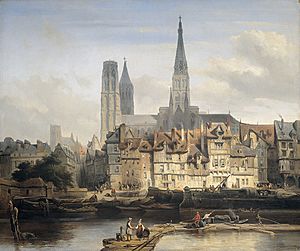François d'Agincourt facts for kids
Quick facts for kids
François d'Agincourt
|
|
|---|---|

An 1839 painting of The Quay de Paris in Rouen. The Rouen Cathedral, where d'Agincourt worked for 52 years, is visible in the background
|
|
| Background information | |
| Born | 1684 Rouen, France |
| Died | April 30, 1758 |
François d'Agincourt (born in 1684, died April 30, 1758) was a famous French musician. He was a talented harpsichordist, organist, and composer. He spent almost his whole life in Rouen, a city in France. There, he worked as the main organist at the Rouen Cathedral and other churches. People thought highly of him during his time. He even played the organ for the French royal family! He wrote beautiful music for the harpsichord, inspired by another great composer, François Couperin. He also wrote about 40 pieces for the organ.
Life of a Musician
François d'Agincourt was born in Rouen, France. He started his music training there. Later, he moved to Paris. He likely studied with a famous musician named Nicolas Lebègue.
From 1701 to 1706, d'Agincourt worked as an organist in Paris. He played at a church called Sainte-Madeleine-en-la-Cité. In 1706, he returned to his hometown of Rouen. He became the organist at the important Rouen Cathedral. He kept this job for 52 years, until he died!
He also worked at other churches in Rouen. These included St. Herbland, the Abbey of Saint-Ouen, and St. Jean. By 1714, he was very well-known. He was chosen as one of the four organists for the French royal chapel. This was a very important position.
A younger musician named Jacques Duphly studied with d'Agincourt around 1730–1731. However, Duphly's music does not show much influence from his teacher.
His Music
François d'Agincourt only published one collection of his music. It was called 1er livre de clavecin (First Book of Harpsichord Music). It came out in Paris in 1733. This book has 43 pieces for the harpsichord. These pieces were clearly influenced by François Couperin.
His harpsichord pieces are organized into ordres (which are like suites or sets of dances). They use a lot of ornamentation (extra musical notes that decorate the main melody). Many of his pieces are "character pieces." These are like musical pictures. They show scenes or portraits of people.
D'Agincourt also wrote music for the organ. About 46 of his organ pieces still exist today. They were copied by hand by a French scientist named Alexandre Guy Pingré. These pieces were meant to be used in church services.
His organ music was more modern than Couperin's organ works. It often used elements of the style galant. This was a lighter, more elegant style of music. The pieces are organized by musical mode (like different scales). However, for some reason, d'Agincourt left out the third mode completely.
Besides his keyboard music, only three songs by d'Agincourt are known. These were published in a collection of songs in 1713 and 1716.
See also
 In Spanish: François d'Agincourt para niños
In Spanish: François d'Agincourt para niños
- French organ school
- French baroque harpsichordists

